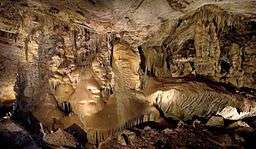Kartchner Caverns State Park
| Kartchner Caverns State Park | |
| Arizona State Park | |
 The Big Room of Kartchner Caverns | |
| Country | United States |
|---|---|
| State | Arizona |
| County | Cochise |
| Location | Benson |
| - elevation | 4,734 ft (1,443 m) [1] |
| - coordinates | 31°50′15″N 110°20′50″W / 31.83750°N 110.34722°WCoordinates: 31°50′15″N 110°20′50″W / 31.83750°N 110.34722°W |
| Biome | Chihuahuan Desert & Madrean Sky Islands |
| Founded | 1988 |
| Management | Arizona State Parks |
 Location of Kartchner Caverns State Park in Arizona
| |
Kartchner Caverns State Park is a state park of Arizona, United States, featuring a show cave with 2.4 miles (3.9 km) of passages.[1] The park is located 9 miles (14 km) south of the town of Benson and west of the north-flowing San Pedro River. Long hidden from view, the caverns were discovered in 1974 by local cavers, assisted by a state biologist who helped in its preservation.
The park encompasses most of a down-dropped block of Palaeozoic rocks on the east flank of the Whetstone Mountains.
The caverns are carved out of limestone and filled with spectacular speleothems which have been growing for 50,000 years or longer, and are still growing. Careful and technical cave state park development and maintenance are designed to preserve the natural cave system.[2]
History
The caverns were discovered in 1974, when cavers Gary Tenen and Randy Tufts found a narrow crack in the bottom of a sinkhole, and followed the source of warm, moist air toward what ended up being more than 2.5 miles (4.0 km) of pristine cave passages with the help of Erick Campbell - a local state biologist.[3][4] Hoping to protect the cave from vandalism, they kept the location a secret for fourteen years, deciding that the best way to preserve the cavern — which was near a freeway — was to develop it as a tour cave. After gaining the cooperation of the Kartchner family and working with them for ten years, together they decided that the best way to achieve the goal of protection through development as a tour cave was to approach Arizona State Parks.[5] In 1985, The Nature Conservancy acquired an option to purchase the land.[6] The discovery of the cave was finally made public in 1988 when the landowners sold the area to the state for development as a park and show cavern. Prior to its grand opening in 1999, the state spent $28 million on a high-tech system of air-lock doors, misting machines and other equipment designed to preserve the cave.[4]
Tourism Information
The two major features of the caverns currently available to the public are the Throne Room and the Big Room. The Throne Room contains one of the world's longest (21 ft 2 in (6.45 m))[4] soda straw stalactites and a 58-foot (18 m) high column called Kubla Khan, after the poem. The Big Room contains the world's most extensive formation of brushite moonmilk; it is closed during the summer for several months (April 15 to October 15) each year because it is a nursery roost for cave bats.[7]
Other features publicly accessible within the caverns include Mud Flats, Rotunda Room, Strawberry Room, and Cul-de-sac Passage. Approximately 60% of the cave system is not regularly explored.[8]
The park also includes hiking trails above the caverns for public use. The longest trail, the Guindani Trail, is 4.2 miles, while the shorter trail, the Foothills Loop Trail, measures 2.5 miles.[9]"

Animal life
Although the cave is largely uninhabited, as many as 2000 Myotis velifer bats nest in the cave during late spring.[10]
Cave formations and vegetation
Many different cave formations can be found within the caves and the surrounding park. These include cave bacon, helictites, soda straws, stalactites, stalagmites and others.[11] Cave formations like the stalactites and stalagmites grow approximately a 16th of an inch every 100 years.[12]
Along the Foothills Loop Trail hike the following plants may be observed: ocotillo, creosote bush, mesquite, desert broom, acacia, wait-a-minute bush, scrub oak, barrel cactus, prickly pear, buckhorn cholla, and hackberry.[9]
Sister caves
 Frasassi Caves [13] (Genga - Marche, Italy)
Frasassi Caves [13] (Genga - Marche, Italy)
References
- 1 2 "Kartchner Caverns State Park". Geographic Names Information System. United States Geological Survey. 2001-02-27. Retrieved 2011-03-12.
- ↑ Arizona State Parks. "Kartchner Caverns State Park: Science".
- ↑ Tufts, Randy; Tenen, Gary (August 1999). "Discovery and History of Kartchner Caverns, Arizona" (PDF). Journal of Cave and Karst Studies. 61 (2): 44–8. ISSN 1090-6924.
- 1 2 3 Rivenburg, Roy (November 14, 1999). "Arizona's Deep, Dark Secret". Los Angeles Times. Retrieved 28 February 2015.
- ↑ Yost, Barbara (2006-07-30). "Underground fantasy". Arizona Republic. pp. T1, T8–9.
- ↑ Grove, Noel (December 1988). "Quietly Conserving Nature". National Geographic. 174 (6): 827.
- ↑ Arizona State Parks. "Cave Tour Information".
- ↑ Dungan, Ron (2010-01-13). "The science behind Kartchner Caverns". The Arizona Republic. Retrieved 2015-02-27.
- 1 2 "Hiking Trails". azstateparks.com. Retrieved 5 March 2015.
- ↑ Buecher, Debbie C.; Sidner, Ronnie M. (August 1999). "Bats of Kartchner Caverns State Park, Arizona" (PDF). Journal of Cave and Karst Studies. 61 (2): 102–7. ISSN 1090-6924.
- ↑ Naylor, Roger (December 5, 2014). "New helmet & headland tour at Kartchner Caverns". The Republic. Retrieved 5 March 2015.
- ↑ Grimes, Thelma (February 12, 2002). "Big room showcased at Karchner Caverns". Benson News-Sun. Retrieved 5 March 2015.
- ↑ "Grotte di Frasassi: Grotte Gemellate".
Further reading
- Miller, Neil. Kartchner Caverns: How Two Cavers Discovered and Saved One of the Wonders of the Natural World, 2008, University of Arizona Press. ISBN 978-0-8165-2516-4
- Larkin, Bruce. Kartchner Caverns, 2009, Wilbooks. ISBN 978-1-60867-258-5.
External links
| Wikimedia Commons has media related to Kartchner Caverns. |